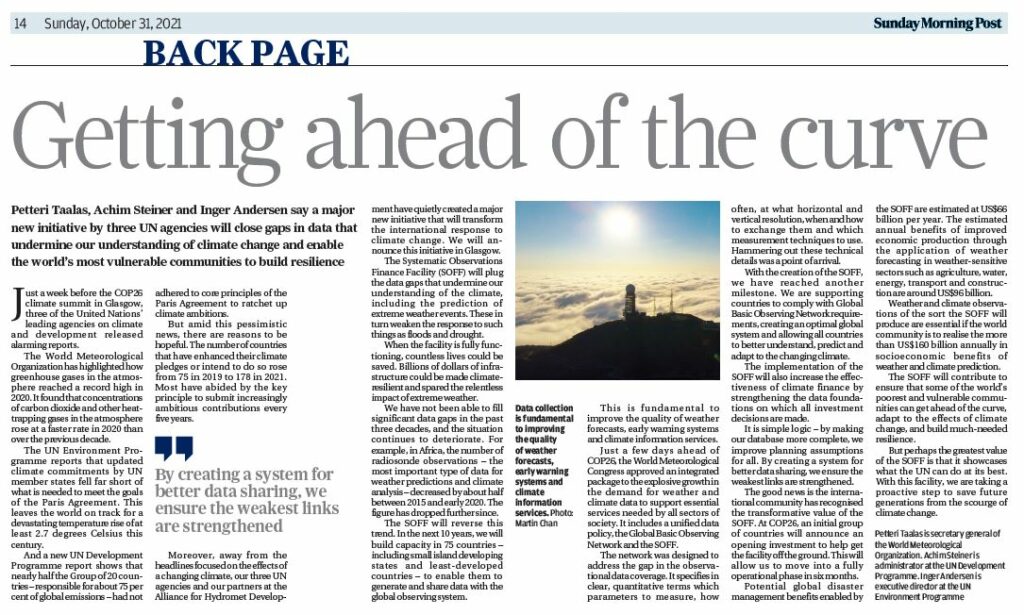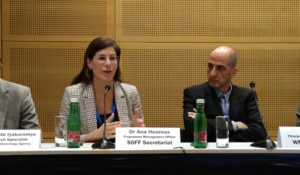COP26: how plugging data gaps will transform our response to climate change

Opinion piece by Petteri Taalas, Achim Steiner and Inger Andersen
31 December 2021: Just a week before the COP26 climate summit in Glasgow, three of the United Nations’ leading agencies on climate and development released alarming reports.
The World Meteorological Organization has highlighted how greenhouse gases in the atmosphere reached a record high in 2020. It found that concentrations of carbon dioxide and other heat-trapping gases in the atmosphere rose at a faster rate in 2020 than over the previous decade.
The UN Environment Programme reports that new and updated climate commitments by UN member states fell far short of what is needed to meet the goals of the Paris Agreement. This leaves the world on track for a devastating global temperature rise of at least 2.7 degrees Celsius this century.
And a new UN Development Programme report shows that nearly half the Group of 20 countries – responsible for about 75 per cent of global emissions – had not adhered to core principles of the Paris Agreement to ratchet up climate ambitions. Even those that have strengthened their nationally determined contributions pledges need to do much more.
But amid this pessimistic news, there are reasons to be hopeful. The number of countries that have enhanced their climate pledges or intend to do so rose from 75 in 2019 to 178 in 2021. Most have abided by the key principle to submit increasingly ambitious contributions every five years.
Moreover, away from the attention-grabbing headlines focused on the devastating effects of a changing climate, our three UN agencies and our partners at the Alliance for Hydromet Development have quietly created a major new initiative that will transform the international response to climate change. We will announce this initiative in Glasgow.
The Systematic Observations Finance Facility (SOFF) will plug the data gaps that undermine our understanding of the climate, including the prediction of extreme weather events. These in turn weaken the response to such things as floods, hurricanes and drought.
When the facility is fully functioning, countless lives could be saved. Billions of dollars of infrastructure could be made climate-resilient and spared the relentless impact of extreme weather.
We have not been able to fill significant data gaps in the past three decades, and the situation continues to deteriorate. For example, in Africa, the number of radiosonde observations – the most important type of data for weather predictions and climate analysis – decreased by about half between 2015 and early 2020. The figure has dropped further since. The same worrying trend is seen in other parts of the world.
The SOFF will reverse this trend. In the next 10 years, we will build capacity in 75 countries – including small island developing states and least-developed countries – to enable them to generate and share data with the global observing system.
This is fundamental to improve the quality of weather forecasts, early warning systems and climate information services across the globe. The implementation of the facility will lead to a 28-fold increase in observational data generated by surface stations and 12 times for radiosondes data compared to January 2020.
Just a few days ahead of COP26, the World Meteorological Congress approved an integrated package to the explosive growth in the demand for weather and climate data to support essential services needed by all sectors of society. It includes a unified data policy, the Global Basic Observing Network and the SOFF.
The network was designed to address the gap in the observational data coverage. It specifies in clear, quantitative terms which parameters to measure, how often, at what horizontal and vertical resolution, when and how to exchange them and which measurement techniques to use. Hammering out these technical details was a point of arrival.
With the creation of the SOFF, we have reached another milestone. We are supporting countries to comply with Global Basic Observing Network requirements, creating an optimal global system and allowing all countries to better understand, predict and adapt to the changing climate.
The implementation of the SOFF will also increase the effectiveness of climate finance by strengthening the data foundations on which all investment decisions are made. By providing a global approach to investing in the collection of weather and climate data, it will allow a more efficient allocation of resources.
It is simple logic – by making our database more complete, we improve planning assumptions for all. By creating a system for better data sharing, we ensure the weakest links are strengthened.
The good news is that the international community has recognised the transformative value of the SOFF. At COP26, an initial group of countries will announce an opening investment to help get the facility off the ground. This will allow us to move into a fully operational phase in six months.
Potential global disaster management benefits enabled by the SOFF are estimated at US$66 billion per year. The estimated annual benefits of improved economic production through the application of weather forecasting in weather-sensitive sectors such as agriculture, water, energy, transport and construction are around US$96 billion.
Weather and climate observations of the sort the SOFF will produce are essential if the world community is to realise the more than US$160 billion annually in socioeconomic benefits of weather and climate prediction.
The SOFF will contribute to ensure that some of the world’s poorest and vulnerable communities can get ahead of the curve, adapt to the effects of climate change, and build much-needed resilience.
But perhaps the greatest value of the SOFF is that it showcases what the UN can do at its best. With this facility, we are taking a proactive step to save future generations from the scourge of climate change.
Petteri Taalas is secretary-general of the World Meteorological Organization. Achim Steiner is administrator at the UN Development Programme. Inger Andersen is executive director at the UN Environment Programme
YOU MAY ALSO LIKE...






